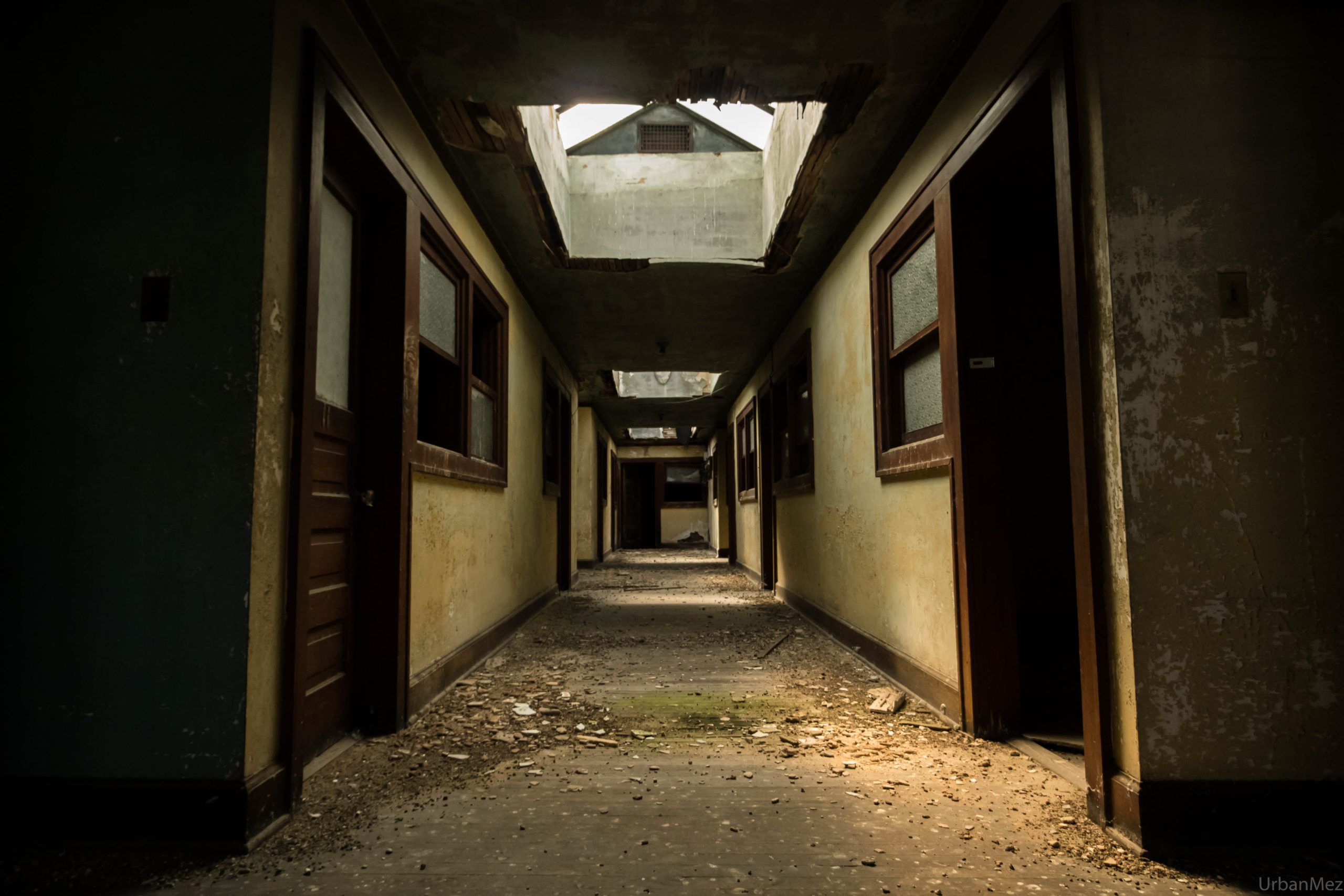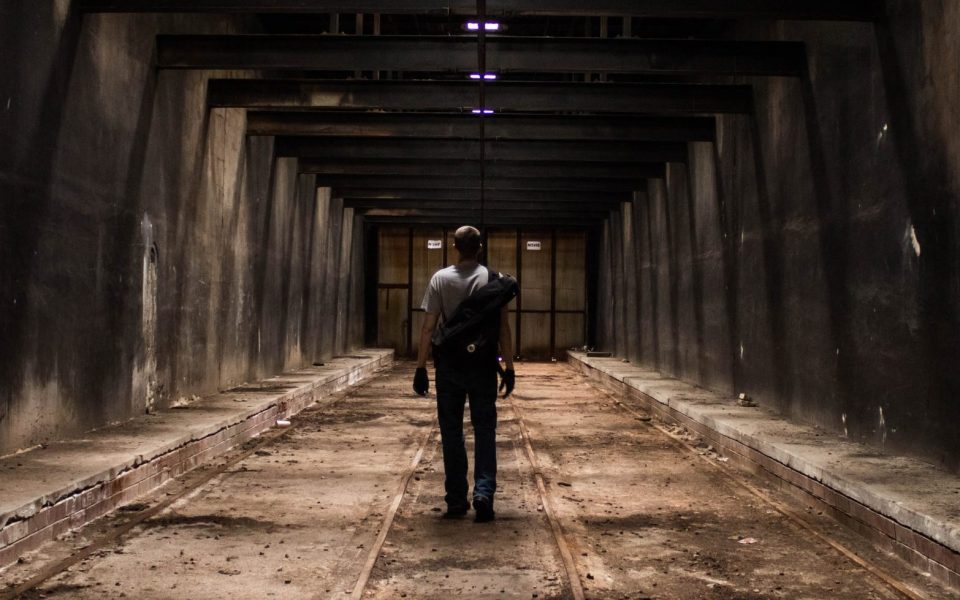Featured photo: Ryan Gustman of Urbanmez in the old train depot in Winston-Salem (photo by Ryan Gustman)
Ryan Gustman knows to avoid pigeon shit.
The white, tacky excrement that gets caked onto city sidewalks and sometimes befalls unsuspecting parkgoers is a lot deadlier than asbestos, according to him.
“I always bring a respirator,” Gustman says. “Because there’s mold, asbestos, all the fun shit. Pigeon shit — that’s a biggie; pigeon crap kills more than asbestos does. People don’t realize, but pigeon lung is a lot worse.”
The 32-year-old photographer waves his hands animatedly as he describes the pack that he carries when he’s working. In addition to a respirator, he makes sure to bring a flashlight — several in fact — his tripod, gloves, a first-aid kit and multiple batteries because, “If you’re underground and your flashlight goes out, you’re dead.”
It’s second nature to him now, after all the years of crawling into tight places, dark crevices and ducking under rusty pipes. It’s part of the job, and it’s something that he’s gotten really good at.
Gustman, who currently operates Urbanmez, his own photography company, has spent years finding his way into and documenting abandoned buildings. Since he started in 2013, he estimates that he’s been in close to 400 or 500 locations, many of them in Winston-Salem. But he still remembers his first.
“That building now is Plant 64 over in Innovation Quarter,” Gustman says. “But before, it was the Reynolds Tobacco warehouse where they did a lot of the curing and processing of the tobacco. And it looked and smelled amazing. Tobacco has this kind of molasses smell to it and all of the paint had been chipping away. A lot of it was green paint falling from the ceiling and of course, it’s all lead paint. And the floors were all wood and the creaking. There’s just a lot to take in from a sensory input perspective.”



After that, he was hooked.
He bought his first digital camera — a cheap Canon Rebel T3 and started seeking out more buildings. At first it was easy, there were a lot to pick and choose from. He made it into the Pepper Building, where he found newspapers from the 1980s and discovered a fallout shelter on Trade Street under Rena Marie’s.
“Under Rena Marie’s there was a Cold War fallout shelter that still had the civilian defense, all the stuff in there, the crackers, a bed setup, a bunch of old dining tables from when that used to be a restaurant in the ‘60s or ‘70s,” Gustman says. “And in one part of it, it had a bunch of original civilian defense stuff. And the door to get in had collapsed so there was no way to get into it unless you went through a kind of like a sewer air thing and I found it and opened it and went to Mike Coe and said, ‘Hey Mike, you have a fallout shelter under here.’”
Finding and capturing images of abandoned buildings was never part of Gustman’s plan. In fact, he had never really pursued any other creative hobbies until he started taking photographs. But after that first experience at the old Reynolds warehouse, he says he felt pulled to see more.

“There’s something visceral about it,” he says. “It’s experiencing a place in true liminality, like an actual space stuck in time, in a way that the average person doesn’t even get to come close to experiencing. Like the closest you could come is maybe going to a foreign country where you don’t understand anything…. Even in a museum it feels fake, but there, it is real and there’s nothing like it.”
As he kept taking photographs, Gustman found that it helped add a balance to his life that he had been missing before. When he was a kid, maybe around five or six years old, Gustman was diagnosed with autism. He describes being hyperactive and not fitting in during much of his life.
“School was a little challenging,” he says. “I went to four different elementary schools, a bunch of middle schools and went to Mt. Tabor for high school. I didn’t graduate and then I went to Forsyth Tech.”
In his early twenties, he says he almost lost himself to alcoholism and depression.
“I needed an outlet or I was going to die,” Gustman says. “Either by suicide or assisted suicide from drinking myself to death. There’s a reason why a lot of people on the spectrum don’t live that long. I found a release. Even normal people need a creative outlet. I didn’t go into abandoned buildings to get a creative outlet but it was a calling.”

As he found more buildings and practiced taking photos, he developed his own process that worked for him.
“I wanted to communicate how it really felt,” he says. “The raw emptiness, the loneliness, the punchiness of the dark. I found that I was capturing that in a way that a lot of other abandoned building people weren’t. Others would add grittiness or light noise.”
A part of Gustman’s process is that he only allows himself three attempts per shot.
“I’ve lost once-in-a-lifetime photos because I didn’t get it in the third attempt,” he says. “But I’ve found that’s what’s worked for me.”
One of his most memorable experiences was when he got access to the Reynolds Building, the “crown jewel of Winston-Salem,” as it was known, before it was renovated in 2016. Gustman believes that he was one of the only photographers that got to capture most of the inside of the building before the changes.
“I went and I found the board room, the Reynolds board room, where they made the decisions that affected billions, if not trillions of people,” Gustman recalls. “When you went in there, it was literally the way it was left. The ornate mirror in the room, the wood paneling, the wallpaper, just left as it was. And then you went into the ‘Think Tank Room’ which had a round board table with four chairs where you could imagine executives would talk for their final authorizations and you could feel the decisions that were made in that room.”


Not long after he got his shots, the entire building was renovated into the Kimpton Cardinal Hotel, the Katharine Brasserie & Bar on the first level and multiple apartment buildings. Gustman was invited to the grand opening and was shocked.
“They took everything out,” he says. “They took every single thing out, the wood paneling has been painted over, the ornate mirrors gone. The red and black theme they had was just gone and it’s a fucking wedding venue now…. That room needs to be in a museum.”
It was around that time that Gustman’s art began capturing the attention of others, prompting news interviews and even a few documentaries. But it became too much, he says.
“I became depressed,” he says. “I was overextending myself partly because of the photography.”
In the last few months, he’s started picking up his camera again, hoping to capture new footage. But it’s been hard, namely because many of the buildings that once dotted the Winston-Salem skyline are gone.



“I want to get back to doing new buildings, but the problem is that Winston-Salem doesn’t have any more buildings,” he says. “There’s nothing left. I’ve been in the Reynolds tunnels. I’ve been in the places that kids have been going into for years. I mean, how do you top the Reynolds building?”
Even so, he says he’s taking his time getting back into it and says he’ll find a way to keep pursuing the artform because it’s important for posterity. His plan is to expand his business and get others to join him in capturing unique footage. He also hopes that the developers moving into the city recognize the need to preserve the buildings’ history and will reach out to his business to do so.
“There’s a song and dance that needs to be done so we don’t lose our history,” Gustman says. “This emotion is a first world problem, but it’s a first world problem until history starts to repeat itself and there’s nothing left to ground people.”
Learn more about Ryan Gustman and his business Urbanmez by visiting his website at urbanmez.com or following his Instagram at @urbanmez.
Join the First Amendment Society, a membership that goes directly to funding TCB‘s newsroom.
We believe that reporting can save the world.
The TCB First Amendment Society recognizes the vital role of a free, unfettered press with a bundling of local experiences designed to build community, and unique engagements with our newsroom that will help you understand, and shape, local journalism’s critical role in uplifting the people in our cities.
All revenue goes directly into the newsroom as reporters’ salaries and freelance commissions.


Leave a Reply